The Commonwealth of Australia
Australia, officially the Commonwealth of Australia, comprises the mainland of the Australian continent, the island of Tasmania, and numerous smaller islands. It is the world’s sixth-largest country by total area. Neighboring countries include Indonesia, East Timor and Papua New Guinea to the north; the Solomon Islands, Vanuatu and New Caledonia to the north-east, The country of New Zealand is located to the south-east of Australia.
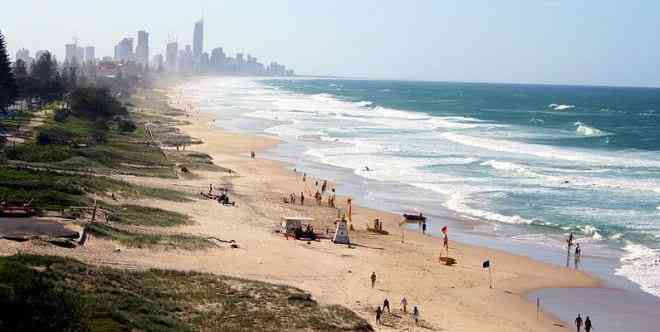
Nearly three quarters of Australians live in metropolitan cities and coastal areas. The beach is an integral part of the Australian identity. Photo by PJ Robertson. License: CC-BY-SA 2.0
Australia is a developed country and one of the wealthiest in the world, with the world’s 12th-largest economy. In 2012 Australia had the world’s fifth-highest per capita income. Australia ranks highly in many international comparisons of national performance, such as quality of life, health, education, economic freedom, and the protection of civil liberties and political rights. Australia is a member of the United Nations, G20, Commonwealth of Nations, and the World Trade Organization along with many other organizations.
Learn something about Australia Take the easy quiz. Can you remember what you read?
States and Territories
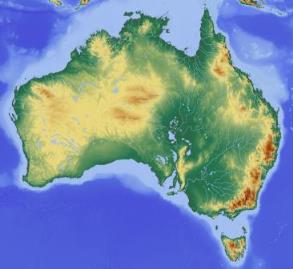
Topographic map of Australia. Photo by Hans Braxmeier. CC-SA-2.5
The Commonwealth of Australia has six states. There is New South Wales (NSW), Queensland (QLD), South Australia (SA), Tasmania (TAS), Victoria (VIC) and Western Australia (WA). In addition there are two territories—the Australian Capital Territory (ACT) and the Northern Territory (NT). In most respects these two territories function as states.
Geography and Climate
The size of Australia’s landmass is 7,617,930 square kilometers or 2,941,300 sq mi. Australia is located on the Indo-Australian Plate. The country is surrounded by the Indian and Pacific oceans. It is separated from Asia by the Arafura and Timor seas, with the Coral Sea lying off the Queensland coast, and the Tasman Sea lying between Australia and New Zealand. The country is the world’s smallest continent and sixth largest country by total area. Australia, due to its size and isolation from other countries, is often called the “island continent”, and is sometimes considered the world’s largest island.
Australia has 34,218 kilometers (21,262 mi) of coastline, not counting all offshore islands. The Great Barrier Reef, the world’s largest coral reef, lies a short distance off the north-east coast. The reef extends over 1,240 miles. Mount Augustus, claimed to be the world’s largest monolith, is located in Western Australia. At 2,228 meters (7,310 ft), Mount Kosciuszko on the Great Dividing Range, is the highest mountain on the Australian mainland. However, even taller are Mawson Peak (at 2,745 meters or 9,006 feet), on the remote Australian territory of Heard Island is taller. Also in the Australian Antarctic Territory, lies Mount McClintock at 11,457 ft and and Mount Menzies at 11,007 ft.
Due to its large size, Australia has a wide variety of landscapes. There are subtropical rainforests in the north-east, mountain ranges in the south-east, south-west and east, and dry desert land in the center of the continent. It is the flattest continent with the oldest and least fertile soils. Desert or semi-arid land commonly known as the outback by far makes up the largest portion of land. As the driest inhabited continent, only its south-east and south-west corners have a temperate climate. The population density of 2.8 inhabitants per square kilometer, is among the lowest in the world, although a large proportion of the population lives along the temperate south-eastern coastline.
The climate of Australia is significantly influenced by ocean currents since the entire country is surrounded by water. These currents include the Indian Ocean Dipole and the El Nino–Southern Oscillation, which is correlated with periodic drought, and the seasonal tropical low-pressure system that produces cyclones in northern Australia. These factors cause rainfall to vary considerably from year to year. Much of the northern part of the country has a tropical, predominantly summer-rainfall (monsoon) climate. The southwest corner of the country has a Mediterranean climate. Much of the southeast including Tasmania is temperate.
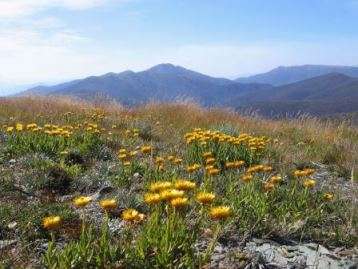
Everlastings on Mount Hotham, located in Victoria, Australia.
Australia’s Economy
Australia is a wealthy country by almost any standard and has a market economy. It has a relatively high GDP per capita, and a relatively low rate of poverty. In terms of average wealth, Australia ranked second in the world after Switzerland in 2013. The the nation’s poverty rate increased from 10.2 per cent to 11.8 per cent, from 2000-01 to 2013. The country was identified by the Credit Suisse Research Institute as the nation with the highest median wealth in the world and the second-highest average wealth per adult in 2013.
Australia is the world’s 12th largest economy and has the 5th highest per capita GDP at $66,984. The country was ranked second in the United Nations 2011 Human Development Index. All of Australia’s major cities fare well in global comparative livability surveys. Australia has among the highest house prices and some of the highest household-debt levels in the world.
Over the past decade, inflation has typically been 2–3% and the base interest rate 5–6%. The country is rich in natural resources and is a major exporter of agricultural products, particularly wheat and wool. Other major exports are minerals such as iron-ore and gold, and energy in the forms of liquified natural gas and coal. Australia’s largest export markets are Japan, China, the US, South Korea, and New Zealand. Australia is the world’s fourth largest exporter of wine, and the wine industry contributes $5.5 billion per year to the nation’s economy.
Australia’s Demographics
The people of Australia are primarily of British and/or Irish ethnic origin. For almost two centuries the majority of settlers, and later immigrants, came from the British Isles. When the 2011 Census was taken they asked respondents to provide a maximum of two ancestries with which they most closely identify. The most commonly nominated ancestry was:
- English (36.1%)
- Australian (35.4%)
- Irish (10.4%)
- Scottish (8.9%)
- Italian (4.6%)
- German (4.5%)
- Chinese (4.3%)
- Indian (2.0%)
- Greek (1.9%)
- and Dutch (1.7%)
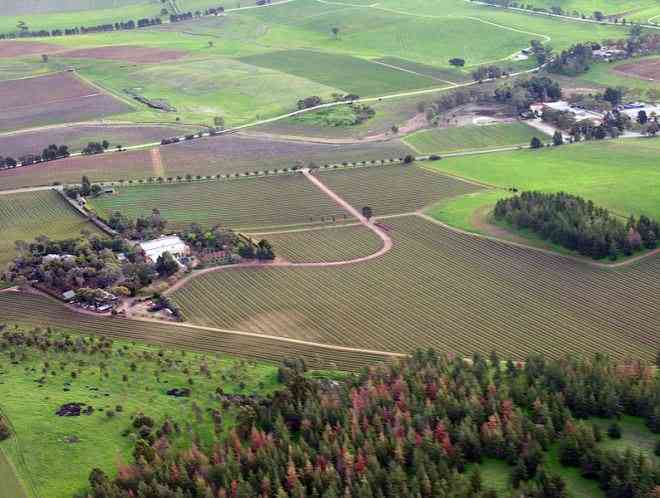
The Barossa Valley is a wine-producing region in South Australia. A small percentage of Australians live in rural areas. Photo by Louis Roving. License: CC-BY-SA 2.0
Asian Australians make up 12% of the population. Australia’s population has quadrupled since the end of World War I. Nevertheless, its population density of 2.8 inhabitants per square kilometer, remains among the lowest in the world. Much of the population increase came from immigration. Following World War II and through to 2000 almost 6 million of the total population settled in the country as new immigrants. By 2050, Australia’s population is currently projected to reach around 42 million.
A large number of Australians, about three-quarters of a million live outside of the country for the period 2002–03. Even more, 1 million or 5% of the total population in 2005 live outside their home country.
Indigenous Australians
There are a small minority of indigenous (Aboriginal) background peoples living in the country. The Indigenous population, mainland Aborigines and Torres Strait Islanders, was counted at 548,370 or 2.5% of the total population in 2011. That was a significant increase from 115,953 in the 1976 census. The increase is partly due to many people with Indigenous heritage previously having been overlooked by the census due to under count and cases where their Indigenous status had not been recorded on the form.
Indigenous Australians experience higher than average rates of imprisonment and unemployment, lower levels of education, and life expectancies for males and females that are about 11 to 17 years lower than those of non-indigenous Australians. Some remote Indigenous communities have been described as having “failed state”-like conditions.
Language
The Commonwealth of Australia has no official language, but English has always been the de facto national language. Australian English is a major variety of the English language with a distinctive accent and lexicon, and differs slightly from other varieties of English in grammar and spelling. According to the 2011 census, English is the only language spoken in the home for close to four-fifths of the population.
The next most common languages spoken at home are Mandarin, Italian, Arabic, Cantonese, Greek, and Vietnamese. A large percentage of first and second generation migrants are bilingual. At the time of the 2006 census, 52,000 Indigenous Australians, representing 12% of the Indigenous population, reported that they spoke an Indigenous language at home.
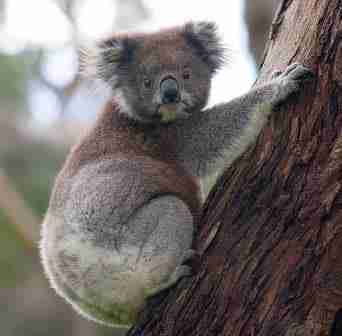
A Koala Bear climbing up a tree, Great Otway National Park, Victoria, Australia. Photo by DAVID ILIFF. License: CC-BY-SA 3.0
Education and Health
School attendance, or registration for home schooling, is compulsory throughout Australia. Education is the responsibility of the individual states and territories so the rules vary between states. In general, children are required to attend school from the age of about 5 up until about 16. In some states children aged 16–17 are required to either attend school or participate in vocational training. Australia has an adult literacy rate that was estimated to be 99% in 2003. However, a 2011–12 report for the Australian Bureau of Statistics reported that Tasmania has a literacy and numeracy rate of only 50%. Australia is among the most expensive nations in the world to attend a university.
Life expectancy in Australia in 2010 was 79.5 years for males and 84.0 years for females. Overall Australia has the fourth highest life expectancy in the world after Iceland, Japan and Hong Kong. Australia has the highest rates of skin cancer in the world. Australia ranks 35th in the world and near the top of developed nations for its proportion of obese adults. Australia introduced universal health care in 1975 known as Medicare.
Culture and Other Facts
Since 1788, the basis of Australian culture has been strongly influenced by Anglo-Celtic Western culture. Since the mid-20th century, American popular culture has strongly influenced Australia, particularly through television and cinema. Other cultural influences come from neighboring Asian countries, and through large-scale immigration from non-English-speaking nations.
The first settlers introduced British food to the continent. Much of that is now considered typical Australian food. The Sunday roast has become a tradition for many Australians. Since the beginning of the 20th century, food in Australia has increasingly been influenced by immigrants to the nation, particularly from Southern European and Asian cultures.
Approximately a quarter of Australians over the age of 15 regularly participate in organized sporting activities. Australia has strong international teams in cricket, field hockey, netball, rugby league, and rugby union, having been Olympic or world champions at least twice in each sport in the last 25 years for both men and women where applicable.
Research published by The Economist in February 2014 showed that gambling is a significant activity in Australia. Per capita, Australian adults lose, on average, more than A$1,100 annually through gambling and the nation is ranked sixth in a list of the highest amount of gambling losses by country. Upon visiting the Melbourne Cup horse race in 1895, writer Mark Twain stated: “Nowhere in the world have I encountered a festival of people that has such a magnificent appeal to the whole nation. The Cup astonishes me.” The race has been celebrated as a public holiday in the state of Victoria.
View the pictures and read article above BEFORE taking quiz.
Take this quiz about the Commonwealth of Australia and see how much you’ve learned or remember.
Answer all questions. Each answer is worth about 10 points. If you don’t know the answer, then take a guess (unless you want a guaranteed zero for the answer). This test is timed (3 min) so be aware of that. Australia is a country you might want to visit, even if you’ve been there before. Consider each of the larger cities as a potential stop during a vacation. To learn more about a city or area in Australia click the link indicated below which will take you to our main travel site.
Quiz #7 Australia
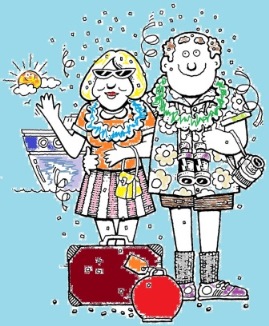 This Travel Quiz is about the Commonwealth of Australia, commonly known as Australia. Some questions have clues while others may not. This quiz also has True/False answers. The level of this test is easy to medium.
This Travel Quiz is about the Commonwealth of Australia, commonly known as Australia. Some questions have clues while others may not. This quiz also has True/False answers. The level of this test is easy to medium.
Great Barrier Reef Travel Video Guide, Queensland Australia
Uploaded to YouTube on Oct 4, 2011
Australia’s Great Barrier Reef stretches across 2300km of Queenslands coastline and offers so many different experiences to be enjoyed. We put put this travel video guide together to give you a brief insight into this natural wonder of the world.
The reef can be accessed from many great QLD destinations such as Cairns, Port Douglas and Townsville, just to name a few. It is also home to a great range of sea animals and birds and is dotted with many beautiful islands like Lady Elliot and Heron all providing you with very unique and enjoyable natural things to do.
Do you have travel perception? Buy my TravelPerception.com and I’ll build you a simple travel website. CLICK HERE.












